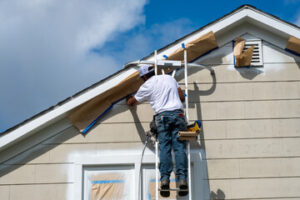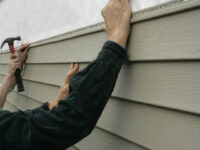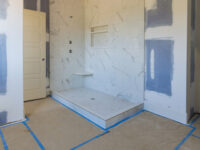The Importance of Hiring Professional Exterior Painters
Painting a home’s exterior is a big job that can add significant value to your property. 
A quality paint job takes time to prepare the surface, kill mildew and other spores, patch, and caulk. Protecting windows, light fixtures, and shrubbery from overspray is also important.
An exterior paint job takes a beating from the elements. High UV rays, rain, and humidity can all wreak havoc on the protective coating that covers it, so you or your hired commercial painters must take the time to prep the surface for new paint properly. While prepping may be the least glamorous part of painting, it’s probably the most crucial.
A good start is to remove any larger furniture items that will obstruct the surfaces you want painted. You’ll also want to remove any smaller objects, like wall hangings and curtains.
Next, a thorough cleaning is needed to ensure that the fresh coat of paint will adhere. It’s a good idea to use a low-pressure power washer with the appropriate cleaning additives, such as sodium hypochlorite or bleach. These solutions will work better and faster than plain water at killing mold, mildew and moss. If you have a multi-story home, you’ll need to rent or purchase a ladder that can support your weight and safely extend to the height of each area you wish to paint.
If there are any shrubs or flowers near the areas you’re going to be working in, you should cover them with a tarp or other material to prevent damage from paint debris. You can also try to tie them back or relocate them for the duration of the painting project. Similarly, you’ll want to protect any water features, such as koi ponds and waterfalls, so that they don’t get inadvertently covered with fresh coats of paint.
You’ll also want to check the surface for any damage that has occurred to your woodwork or stucco, and fix it as necessary. For example, if a nail pops out of the side of a board, you’ll need to hammer it back in and then nail it again to ensure that a fresh coat of paint will hold securely.
Finally, you’ll need to make sure that all caulk is intact around the edges of your home, to prevent moisture from seeping in and creating a potential future problem. A thorough inspection will reveal any spots where the caulking is loose or peeling.
Selection of Colors
The color selection for a home’s exterior is one of the most important parts of any residential painting project. There are many factors to consider, and a professional opinion can go a long way in ensuring the success of your new color scheme. Start by looking at homes in your neighborhood to find examples of color schemes that work well. You can also ask a local residential painting company about their favorite exterior paint colors. They will likely have experience working on a variety of different types of houses and can provide valuable feedback.
The type of material that makes up your home’s exterior should play a role in the color choices you make. Stone, brick, and other materials that aren’t painted will have undertones that influence how a certain color will look on your house. For this reason, it’s best to choose a paint color that either matches these undertones or works in harmony with them. If you’re unsure of which shade to choose, try testing your options on a small section of the exterior. This will give you a better idea of how the color will look under different lighting conditions and in different weather.
Timeless colors like blue, yellow, or red can be great choices for a traditional home. They are crowd-pleasing and can add a pop of personality without being overpowering. For a more modern or eclectic style, you can experiment with bolder colors and create something truly unique.
When choosing a color for your home, it’s also important to take into account the surrounding neighborhood. While you don’t have to match your home with those of the neighbors, a clash can detract from curb appeal and may even make your house appear less desirable to potential buyers. In this case, it’s best to choose a color that complements, but doesn’t mirror, your neighbors’ homes.
Finally, it’s generally a good idea to stick to three colors or shades for your home’s exterior. More than that can be overwhelming and can cause your home to feel disjointed and unfinished.
Application
Painting a home’s interior or exterior can make the world of difference to its curb appeal. The right color can bring out the details in trim work, cover up a dated look or give a house a real stand-out on the block. It can even increase its resale value. But, it takes special skills and equipment to do a good job. Hiring professional residential exterior painters is the way to go.
In addition to the prep work and sanding, exterior painting involves cleaning and caulking windows and doors as well as masking anything that is not going to be painted. It also requires the use of power washers and scrapers to ensure a clean and smooth surface for the new paint. A great paint job should last for a long time, but it is important that it be done correctly to prevent water damage and other issues.
Exterior painters can help homeowners with the process of choosing the right color, determining how much paint will be needed and what is needed to prepare the surfaces before painting. They can also provide recommendations for stains and sealers to protect the new paint once it is applied.
One of the key things to look for in an exterior painter is whether they use a water-based or oil-based product. Both kinds of paint have their advantages, but they are not interchangeable. They are designed for different purposes and are formulated to resist specific weather conditions. For example, latex and acrylic paints will not hold up in cold, snowy winter weather. Oil-based products are better suited for these conditions.
It is also important to choose a painting company that specializes in both interior and exterior painting. This will ensure that they have the skills and knowledge to tackle both types of projects in a timely and efficient manner. They will also know the right type of paint to use and will be able to recommend a product that is rated for outdoor use. It is also important to choose a company that will guarantee their work and will supply a written estimate and contract before any painting begins. This will protect the homeowner in case something goes wrong during the project.
Maintenance
An exterior paint job is not only about improving the look of your building; it’s also a protective coating that helps to prevent wood rot, weathering, organic growth and insect invasion. However, the paint system deteriorates over time, and maintenance is essential to prolonging its life. It’s recommended to perform touch-up painting after every one or two years.
This will ensure that any areas where the paint has failed are treated promptly. In addition, it will also extend the overall durability of the paint, reducing the frequency at which you will need to repaint the entire surface.
The type of material your home’s exterior is constructed from, its location and the quality of the craftsmanship of the previous painting or staining jobs will determine how long your current surface will last. As a general rule, wood surfaces need to be painted or stained every 3-7 years and metal siding every 5-10. The best way to make sure that your new surface lasts is to work with a professional contractor who will use high-quality materials.
Before you hire someone to perform your project, request detailed bids from several contractors. Ask each to provide the names and phone numbers of satisfied customers who they have worked for, and if possible, visit these homes to see their work. This will help you avoid hiring an inexperienced painter or paying too much for a low-quality job.
Once you have selected a contractor, be clear about what you are hoping to achieve. The contractor will offer varying opinions and suggestions – after all, they are experts – but you have the final say on color, finish types and more. Don’t be afraid to speak up if you feel a push toward a choice that is not in line with your vision.
A good painter will not only price your project based on the amount of square footage, number of coats and other factors, they will also provide a quote for any necessary repairs. They will not overcharge for paint or other products, and they will be honest about the amount of gallons you will need to cover your project. It is important to note that each gallon of paint covers 300 to 400 square feet, so be careful not to overbuy.






